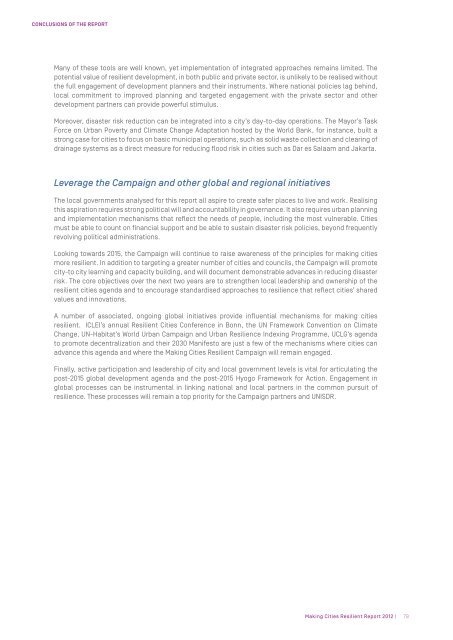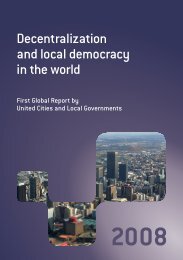Making Cities Resilient Report 2012
Making Cities Resilient Report 2012
Making Cities Resilient Report 2012
Create successful ePaper yourself
Turn your PDF publications into a flip-book with our unique Google optimized e-Paper software.
CONCLUSIONS OF THE REPORT<br />
Many of these tools are well known, yet implementation of integrated approaches remains limited. The<br />
potential value of resilient development, in both public and private sector, is unlikely to be realised without<br />
the full engagement of development planners and their instruments. Where national policies lag behind,<br />
local commitment to improved planning and targeted engagement with the private sector and other<br />
development partners can provide powerful stimulus.<br />
Moreover, disaster risk reduction can be integrated into a city’s day-to-day operations. The Mayor’s Task<br />
Force on Urban Poverty and Climate Change Adaptation hosted by the World Bank, for instance, built a<br />
strong case for cities to focus on basic municipal operations, such as solid waste collection and clearing of<br />
drainage systems as a direct measure for reducing flood risk in cities such as Dar es Salaam and Jakarta.<br />
Leverage the Campaign and other global and regional initiatives<br />
The local governments analysed for this report all aspire to create safer places to live and work. Realising<br />
this aspiration requires strong political will and accountability in governance. It also requires urban planning<br />
and implementation mechanisms that reflect the needs of people, including the most vulnerable. <strong>Cities</strong><br />
must be able to count on financial support and be able to sustain disaster risk policies, beyond frequently<br />
revolving political administrations.<br />
Looking towards 2015, the Campaign will continue to raise awareness of the principles for making cities<br />
more resilient. In addition to targeting a greater number of cities and councils, the Campaign will promote<br />
city-to city learning and capacity building, and will document demonstrable advances in reducing disaster<br />
risk. The core objectives over the next two years are to strengthen local leadership and ownership of the<br />
resilient cities agenda and to encourage standardised approaches to resilience that reflect cities’ shared<br />
values and innovations.<br />
A number of associated, ongoing global initiatives provide influential mechanisms for making cities<br />
resilient. ICLEI’s annual <strong>Resilient</strong> <strong>Cities</strong> Conference in Bonn, the UN Framework Convention on Climate<br />
Change, UN-Habitat’s World Urban Campaign and Urban Resilience Indexing Programme, UCLG’s agenda<br />
to promote decentralization and their 2030 Manifesto are just a few of the mechanisms where cities can<br />
advance this agenda and where the <strong>Making</strong> <strong>Cities</strong> <strong>Resilient</strong> Campaign will remain engaged.<br />
Finally, active participation and leadership of city and local government levels is vital for articulating the<br />
post-2015 global development agenda and the post-2015 Hyogo Framework for Action. Engagement in<br />
global processes can be instrumental in linking national and local partners in the common pursuit of<br />
resilience. These processes will remain a top priority for the Campaign partners and UNISDR.<br />
<strong>Making</strong> <strong>Cities</strong> <strong>Resilient</strong> <strong>Report</strong> <strong>2012</strong> | 79

















